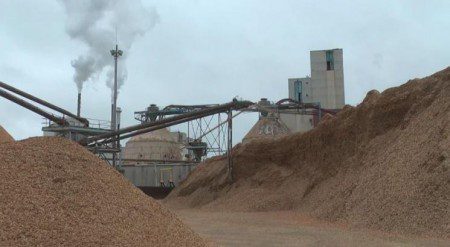The pulp mill in Old Town that has been propped up with millions in federal and state aid has tentatively won its battle to double its allowed pollution rather than fix or replace its aging boiler.
The state Department of Environmental Protection (DEP) announced on July 14 it would grant most of the Old Town Fuel & Fiber pulp mill’s request to increase its permitted carbon monoxide emissions. The mill has asked to go from 407 tons per year to 1,045; the state approved a 929-ton maximum. Average permitted daily emissions would also be allowed to increase.
The decision is not final, however. There is a period for public comment and after that, even if the head of the state DEP, Patricia Aho, gives final approval, the decision can be appealed to the Board of Environmental Protection, a citizen panel that oversees the department’s work.
Some environmental activists in the Old Town area are skeptical about the DEP decision. Ed Spencer, an Old Town logger, said he probably will ask the Board of Environmental Protection (BEP) to consider the issue and hold a public hearing.
In January, the Maine Center for Public Interest Reporting described how the mill for years had exceeded pollution limits, paying hundreds of thousands of dollars in penalties to the DEP and the federal Environmental Protection Agency. At the same time, the federal and state governments have given the mill tens of millions of dollars to support its operations.
DEP is still negotiating with the mill over a $497,000 pollution fine the department proposed last year, although that number is just a starting point for talks.
A practical effect of the new emissions ceilings would be to eliminate future fines for the mill because it could now legally have what had been excess emissions.
Melanie Loyzim, the DEP air quality bureau director, wrote in an email that the mill’s emissions are “far less than levels that would cause a harmful concentration of carbon monoxide in the air.”
Carbon monoxide is a colorless, odorless, poisonous gas that can be harmful to people with heart disease.
Loyzim said the department’s computer modeling shows the pollution will be dispersed well enough so as not to violate the EPA’s National Ambient Air Quality Standards.
The Board of Environmental Protection would only take jurisdiction if, among other factors, the proposal affects a large geographic area, involves a natural resource of statewide significance, or there’s conflicting technical information on whether the air-quality licensing standards would be met by the change proposed, according to Marc Cone, the air quality bureau’s licensing and compliance chief.
The deadline for opponents of the emissions hike to request a hearing by the Board is August 3.
The public can also request a DEP informational public meeting if the request is made before July 30. The DEP has already tentatively scheduled one for 7 p.m. Aug. 14 at the Black Bear Inn in Orono. The deadline for the DEP to receive written comments is Aug. 13.
Old Town Fuel & Fiber — also called Red Shield — has made investments this year in upgrading the boiler, Loyzim said.
In late 2008, the mill was bought at auction for $19 million by Patriarch Partners, an $8 billion private-equity conglomerate. The facility was renamed Old Town Fuel & Fiber. In addition to producing pulp, the mill is experimenting with making butanol, a fuel, from pulp.
The carbon-monoxide increase would be allowed only until the end of 2015, when more stringent federal pollution limits are expected to go into effect. In its written decision — technically a draft air-emission-license amendment — the DEP says the mill would then have to reduce its carbon-monoxide releases to 523 tons per year, close to its present limit.
Another mill pollutant, sulfur dioxide, will also be allowed to increase, from 97 to 111 tons per year. The emissions all come from the mill’s 1980s-era biomass boiler, which has long been troublesome.
During the three-plus years the mill will be allowed to increase its pollution, the mill will have the opportunity “to continue to fine-tune the unit,” including having experts examine the boiler, according to the DEP.
The mill general manager, Michael Footer, said he could not respond to questions about the DEP decision without first getting “clearance” from other company officials, but this was not forthcoming before deadline.
Environmental groups are not up in arms over the proposed boost in the mill’s pollution. Both the Natural Resources Council of Maine (NRCM) and the Clean Air Task Force said they’re not working on the issue.
“We’re completely swamped with other stuff,” said Nick Bennett, the NRCM’s staff scientist.
Jake Ward, assistant vice president at the University of Maine in nearby Orono, expressed confidence that regulators would suitably deal with the mill’s pollution.
The university has continued to build its partnership with Old Town Fuel & Fiber, in June opening a Technology Research Center on rent-free mill grounds. The 40,000-square-foot facility will develop fuels distilled from wood, in collaboration with private industry.
The university’s partnership with a mill that continually has exceeded pollution limits is irksome to Paul Schroeder, an Orono resident.
“The university should be running a cleaner ship,” he said.
Ward responded: “I’m not sure there’s anything we can do” to influence the mill’s operations.
Mill also got $500,000 Pine Tree tax break
In January, the Maine Center for Public Interest Reporting added up federal and state grants and tax breaks listed in public records that the Old Town pulp mill has received or been promised during the past nine years.
The sum: $56.5 million. Now add $498,514, which the mill received from the state because, for 2010, it qualified for Employment Tax Increment Financing (ETIF) under the state’s Pine Tree Development Zone economic-development program.
The payment was made because the mill had created new jobs — in this case, 211 “qualified employees” — even though it has employed workers for more than 100 years, and the employment level is much lower than at many times in the past.
As the state Department of Economic and Community Development (DECD) describes the ETIF program, “businesses are reimbursed up to 80 percent of their new employees’ Maine income tax withholdings for up to 10 years.”
The $498,514 sum is only one year of ETIF reimbursement. DECD has said it could not locate reports from other years in which the mill may have received the tax break.







